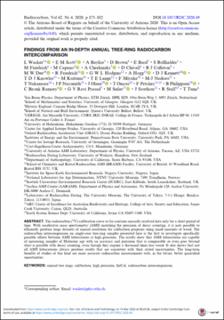| dc.contributor.author | Wacker, Lukas | |
| dc.contributor.author | Scott, Ethel Marian | |
| dc.contributor.author | Bayliss, Alex | |
| dc.contributor.author | Brown, David | |
| dc.contributor.author | Bard, Édouard | |
| dc.contributor.author | Bollhalder, Silvia | |
| dc.contributor.author | Friedrich, Michael | |
| dc.contributor.author | Capano, Manuela | |
| dc.contributor.author | Cherkinsky, Alexander | |
| dc.contributor.author | Chivall, David | |
| dc.contributor.author | Culleton, Brendan J. | |
| dc.contributor.author | Dee, Michael W | |
| dc.contributor.author | Friedrich, Ronny | |
| dc.contributor.author | Hodgins, Gregory W.L. | |
| dc.contributor.author | Hogg, Alan G. | |
| dc.contributor.author | Kennett, Douglas J. | |
| dc.contributor.author | Knowles, Timothy D. | |
| dc.contributor.author | Kuitems, Margot | |
| dc.contributor.author | Lange, Todd E. | |
| dc.contributor.author | Miyake, Fusa | |
| dc.contributor.author | Nadeau, Marie-Josée | |
| dc.contributor.author | Nakamura, Toshio | |
| dc.contributor.author | Naysmith, J.P. | |
| dc.contributor.author | Olsen, Jesper | |
| dc.contributor.author | Omori, Toshihiko | |
| dc.contributor.author | Petchey, Fiona | |
| dc.contributor.author | Philippsen, Bente | |
| dc.contributor.author | Ramsey, Christopher Bronk | |
| dc.contributor.author | Prasad, G.V.A. | |
| dc.contributor.author | Seiler, Martin | |
| dc.contributor.author | Southon, John | |
| dc.contributor.author | Staff, Richard A. | |
| dc.contributor.author | Tuna, Thibaut | |
| dc.date.accessioned | 2022-03-14T09:08:48Z | |
| dc.date.available | 2022-03-14T09:08:48Z | |
| dc.date.created | 2022-01-11T16:57:54Z | |
| dc.date.issued | 2020 | |
| dc.identifier.issn | 0033-8222 | |
| dc.identifier.uri | https://hdl.handle.net/11250/2984956 | |
| dc.description.abstract | The radiocarbon (14C) calibration curve so far contains annually resolved data only for a short period of time. With accelerator mass spectrometry (AMS) matching the precision of decay counting, it is now possible to efficiently produce large datasets of annual resolution for calibration purposes using small amounts of wood. The radiocarbon intercomparison on single-year tree-ring samples presented here is the first to investigate specifically possible offsets between AMS laboratories at high precision. The results show that AMS laboratories are capable of measuring samples of Holocene age with an accuracy and precision that is comparable or even goes beyond what is possible with decay counting, even though they require a thousand times less wood. It also shows that not all AMS laboratories always produce results that are consistent with their stated uncertainties. The long-term benefits of studies of this kind are more accurate radiocarbon measurements with, in the future, better quantified uncertainties. | en_US |
| dc.language.iso | eng | en_US |
| dc.publisher | Cambridge University Press | en_US |
| dc.rights | Navngivelse 4.0 Internasjonal | * |
| dc.rights.uri | http://creativecommons.org/licenses/by/4.0/deed.no | * |
| dc.title | Findings from an in-Depth Annual Tree-Ring Radiocarbon Intercomparison | en_US |
| dc.type | Peer reviewed | en_US |
| dc.type | Journal article | en_US |
| dc.description.version | publishedVersion | en_US |
| dc.source.journal | Radiocarbon: An International Journal of Cosmogenic Isotope Research | en_US |
| dc.identifier.doi | 10.1017/rdc.2020.49 | |
| dc.identifier.cristin | 1978751 | |
| cristin.ispublished | true | |
| cristin.fulltext | postprint | |
| cristin.qualitycode | 1 | |

